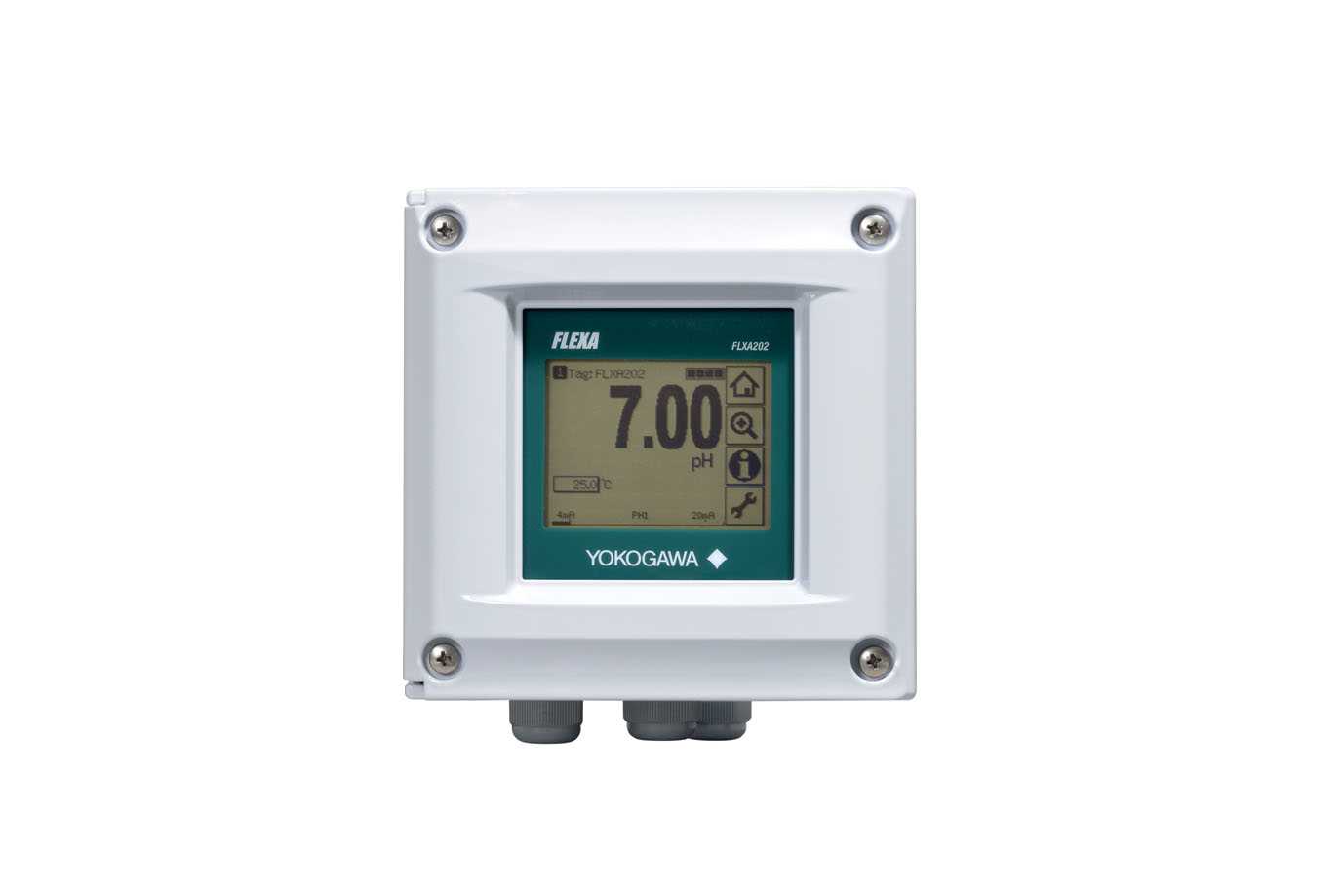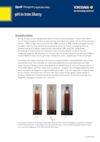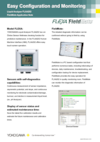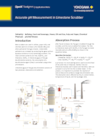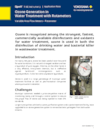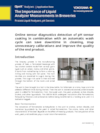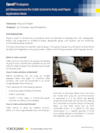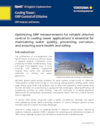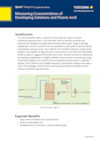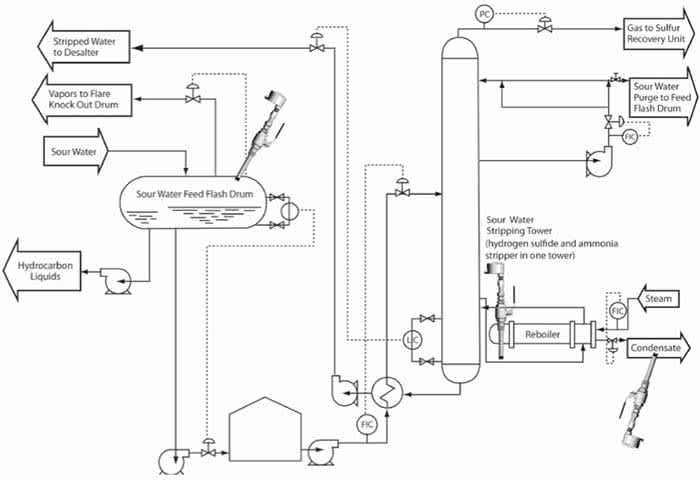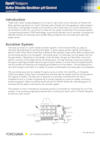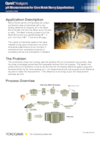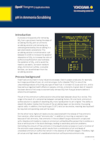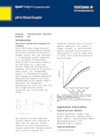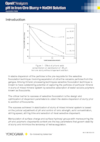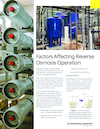The FLEXA™ series analyzers are modular-designed analyzers used for continuous online measurements in industrial installations. They offer single or dual sensor measurement, making them the most flexible 2-wire analyzer available.
With the FLXA202, there is no need for multiple analyzers as it is easily scalable at the site location. By swapping the internal measurement module to what is needed, users have more flexibility to optimize their OPEX.
What Is an Analyzer/Transmitter?
Transmitters and analyzers communicate a range of measurement data to help detect, diagnose, and predict problems to maintain plant performance and profitability. Analyzers and transmitters play an important role in many industries, including chemical plants, water treatment, industrial water, oil & gas, pulp & paper, and food & beverage.
Details
Main Features
Support of Up to Two Sensors
 Through the installation of up to two sensors, FLXA202 realizes interruption-free measurement even during maintenance. For dual sensor measurement, the sensor modules must be the same parameter – pH/ORP and pH/ORP, SC and SC, and DO and DO. Dual sensor measurement offers additional functionalities including a variety of calculated data from the two measuring parameters, as well as, the option to program the analyzer as a redundant system.
Through the installation of up to two sensors, FLXA202 realizes interruption-free measurement even during maintenance. For dual sensor measurement, the sensor modules must be the same parameter – pH/ORP and pH/ORP, SC and SC, and DO and DO. Dual sensor measurement offers additional functionalities including a variety of calculated data from the two measuring parameters, as well as, the option to program the analyzer as a redundant system.
Advanced Functions
With the FLXA202, one analyzer can accept any of four types of measurements: pH/ORP, Contacting Conductivity (SC), Inductive Conductivity (ISC) and Dissolved Oxygen (DO)Sensors with self-diagnostics capabilities. Additional functions include:
- Continuous measurement of sensor impedance, asymmetric potential, and slope, and continuous monitoring for electrode contamination/damage, burnout, and decline in measurement liquid level (ex. pH Analyzer).
- Online Sensor Wellness checking for predictive maintenance.
Clear Touch Panel Display for Improved Operability
The FLEXA™ series analyzer provides improved operability with intuitive touchscreen operation, featuring a clear display and user-friendly indication with 12 languages. A quick setup menu for immediate measurement and a display of sensor status and estimated maintenance time improve efficiency. The interactive screen is housed in a robust aluminum die-cast housing (FLXA202).
Modular Design for Increased Scalability
The FLEXA™ series analyzer features a modular design with replaceable sensor modules, enabling the construction of a variety of systems. Users can opt to do without a display and can also select the case material (plastic or stainless steel).
Common Specification
| Area Classification | General Purpose Class I Div II (without the use of IS Barrier) Class I Div I (with the use of IS Barrier) |
|---|---|
| Enclosure Material | Aluminum alloy die cast with epoxy coating (Standard offering Aluminum alloy die cast with urethane or high anti-corrosion coating (available upon request) |
| Housing Rating | IP66 (except Canada), Type 4X (except Canada), Type 3S/4X (Canada) |
| Power Supply | 2-wire 24VDC Loop Powered |
| Output Signal | Bi-directional HART digital communication, superimposed on mA (4-20mA) signal |
| Intrinsically safe type | ATEX, IECEx, FM, CSA and NEPSI, and nonincendive of FM and CSA |
What Are the Benefits of pH / ORP Measurement?
Achieves high-precision pH measurement
- Built-in calibration standard table with temperature compensation function and stability check function.
- The detector status is checked and monitored in real time.
- Temperature and oxidation-reduction potential (ORP) can also be measured.
Reduced maintenance man-hours by checking health level and predicting maintenance timing
- Continuously measures the impedance, asymmetric potential, slope, etc. of the detector to continuously self-diagnose the status of the detector, such as contamination/damage, disconnection of the electrode, lowering of the measuring liquid level, etc.
- Save the latest five calibration results to predict the health of the detector and future maintenance and calibration timing.
Compatible with various other types of explosion-proof
pH / ORP Measurement Specification
| Input Range | pH: -2 to 16 pH (with option /K: 0 to 14 pH) ORP: -1500 to 1500 mV rH: 0 to 100 rH Temperature: Pt1000, Pt100, 6.8k, PTC10k, 3k Balco, PTC500: -30 to 140 ºC, NTC 8k55: -10 to 120 ºC |
|
|---|---|---|
| Performance (The specifications are expressed with simulated inputs.) |
pH | Linearity: ±0.01 pH, Repeatability: ±0.01 pH, Accuracy: ±0.01 pH |
| ORP | Linearity: ±1 mV, Repeatability: ±1 mV, Accuracy: ±1 mV | |
| Temperature | with Pt1000, PTC500, 6.8k, PTC10k, NTC 8k55, 3k Balco Linearity: ±0.3 ºC, Repeatability: ±0.1 ºC, Accuracy: ±0.3 ºC |
|
| with Pt100 Linearity: ±0.4 ºC, Repeatability: ±0.1 ºC, Accuracy: ±0.4 ºC |
||
Sensors to combine
Analog Sensors
The analog detector connects directly to the FLXA202 module.
Please confirm the details of each detector from the following.
→ pH sensors/ORP sensors

SENCOM smart adapter SA11 compatible sensor
When used as a digital compatible sensor, it is used in combination with the SA11 SENCOM smart adapter.
Applicable to the following detectors with Variopin connector option.
→ All-in-One pH/ORP (REDOX) Sensor FU20 and FU24
→ Wide Body Sensor for Water and Wastewater PH21
→ pH/ORP Sensors PH8EFP/PH8ERP
→ Pure Water pH and ORP Sensors PH8EHP

What Are the Benefits of Conductivity / Resistivity Measurement?
Realizes highly versatile and high-precision measurement
- The built-in temperature compensation function and calibration standard table enable higher-precision conductivity measurement by monitoring the contamination of the cell.
- Cell constants correspond to 0.005 to 50 cm-1.
- Both 2-electrode and 4-electrode sensors can be used.
- Five types of temperature detectors are supported, and accurate temperature compensation (linear temperature compensation/matrix temperature compensation) is performed.
Pure water and compliance with stringent standards for WFI monitoring (USP item <645>)
- In the analysis of demineralized water, steam, condensate, and boiler water, pure water compensation is performed.
- Monitors the quality of the process solution in accordance with the USP (U.S. PHARMACEUTICAL) entry <645> (see Section 645 of USP23) guideline (U.S. PHARMACEUTICAL GUIDE), which serves as the basis for monitoring pure water in the PHARMACEUTICAL INDUSTRY.
Compatible with various other types of explosion-proof
Conductivity / Resistivity Measurement Specification
| Input Specification | Two or four electrodes measurement with square wave excitation, using max 60m (200ft) cable (WU40/WF10) and cell constants from 0.005 to 50.0 cm-1 | |
|---|---|---|
| Display range | Conductivity | min. 0.01 µS/cm, max. 2000 mS/cm (max 90% zero suppression) |
| Resistivity | min. 0.001 kΩ x cm, max. 1000 MΩ x cm (max 90% zero suppression) | |
| Temperature | min. span 25 ºC, max. span 270 ºC | |
| Performance (Accuracy)(The specifications are expressed with simulated inputs.) |
Conductivity | 2 µS x K cm-1 to 200 mS x K cm-1: Accuracy: ±0.5%F.S. 1 µS x K cm-1 to 2 µS x K cm-1: Accuracy: ±1%F.S. |
| Resistivity | 0.005kΩ / K cm-1 to 0.5MΩ /K cm-1: Accuracy: ±0.5%F.S. 0.5MΩ / K cm-1 to 1MΩ /K cm-1: Accuracy: ±1%F.S. |
|
| Temperature | with Pt1000, Pb36, Ni100: Accuracy: ±0.3 ºC with Pt100, NTC 8k55: Accuracy: ±0.4 ºC |
|
| Temperature compensation | NaCl table: ±1 % Matrix: ±3 % |
|
| Temperature | 90 % (< 2 decades) in 7 seconds | |
Sensors to combine
Analog Sensors
The analog detector connects directly to the FLXA202 module.
Please confirm the details of each detector from the following.
→ Conductivity Sensors

SENCOM smart adapter SA11 compatible sensor
When used as a digital compatible sensor, it is used in combination with the SA11 SENCOM smart adapter.
Applicable to the following detectors with Variopin connector option.
→ Contacting Conductivity Sensors SC42/SC4A

What Are the Benefits of Inductive Conductivity Measurement?
Strong acid and strong alkali are also measured, and high-precision measurement with confidence is available for a wide range of applications.
- For non-contact measurement, it is subject to measurement from acid and alkaline solutions to salt-containing solutions.
- It has a matrix compensation and output linearization function to accurately analyze solutions of strong acid and strong alkali.
- Level monitoring in the chemical industry, food and chemical industries, plating and surface treatment industries, paper and pulp industries, etc. makes measurements of electromagnetic conductivity for a wide range of applications with high accuracy.
Output function
- One 4-20 mA output for recording, display, and control.
- Select the measurement parameter from Conductivity, Level or Temperature.
- Only one sensor can be connected.
Compatible with various other types of explosion-proof
Inductive Conductivity Measurement Specification
| Input Specification | Compatible with the Yokogawa inductive conductivity ISC40 series with integrated temperature sensor: NTC30k or Pt1000. | |
|---|---|---|
| Input Range | Conductivity | 0 to 2000 mS/cm at 25 ºC reference temperature. |
| Temperature | -20 to 140 ºC | |
| Cable length | max. 60 meters total length of fixed sensor cable + WF10(J) extension cable. Influence of cable can be adjusted by doing an AIR CAL with the cable connected to a dry cell. |
|
| Performance (The specifications are expressed with simulated inputs.) |
Conductivity | Linearity: ±(0.4 %F.S. + 0.3 µS/cm) Repeatability: ±(0.4 %F.S. + 0.3 µS/cm) |
| Temperature | ±0.3 ºC | |
| Step response | 90 % (< 2 decades) in 8 seconds | |
Sensors to combine
Analog Sensors
The analog detector connects directly to the FLXA202 module.
Please confirm the details of each detector from the following.
→ Conductivity Sensors

What Are the Benefits of Dissolved Oxygen Measurement?
Process Analyzer with High Functionality, High Reliability, and Reduced Maintenance
Can be used under severe environmental conditions and is ideal for on-site installation
- Either galvanic or polarographic sensors can be used.
- Indicated units are mg/L, ppm and % saturation.
- Corrections are made for changes in atmospheric pressure, salinity, and temperature depending on altitude, etc., even in harsh environments.
- High-precision measurement is possible.
- One 4-20 mA output is provided for recording, display, and control.
- Concentration, temperature or calculated values of the two detectors, plus the following output functions are also configurable:
- Hold function: Hold the output signal to the last measured value or fixed value (hold).
- Burnout function: Burn-up (22.0mA) or burn-down signal (3.6 mA) is output in case of failure.
Compatible with various other types of explosion-proof
Dissolved Oxygen Measurement Specification
| Input Specification | The FLXA202 accepts output from membrane covered Dissolved Oxygen sensors. These sensors can be Galvanic type, where the sensor generates its own driving voltage or Polarographic type, where the sensor uses external driving voltage from the converter. The input range is 0 to 50 µA for Galvanic sensors and 0 to 1 µA for Polarographic sensors. For temperature compensation, the FLXA202 accepts Pt1000 (DO30 sensor) and NTC22k elements (OXYFERM and OXYGOLD sensors). |
|
|---|---|---|
| Measurement Range | DO Sensors | Dissolved Oxygen: 0 to 50 mg/l (ppm) Temperature: -20 to 150 ºC |
| DO30G | Measurement range: 0 to 20 mg/l (ppm) Temperature: 0 to 40 ºC |
|
| Performance (Accuracy) (Performance in ppm mode) |
Linearity | ±0.05 ppm or ±0.8% F.S., whichever is greater |
| Repeatability | ±0.05 ppm or ±0.8% F.S., whichever is greater | |
| Accuracy | ±0.05 ppm or ±0.8% F.S., whichever is greater | |
| Temperature | Linearity: ±0.3 ºC Repeatability: ±0.1 ºC Accuracy: ±0.3 ºC |
|
Sensors to combine
Analog Sensors
The analog detector connects directly to the FLXA202 module.
Please confirm the details of each detector from the following.
→ Dissolved Oxygen Sensors

Resources
Measurement of pH in high purity water presents many difficulties. Yokogawa's pH instrument's design success comes from addressing the unique challenges of the application.
Conductivity measurement can be used as a reliable indicator of the real-time brine concentration. Using an online process analyzer removes the need for timely grab sample analysis.
Wet scrubbers are used in utilities, paper mills, and chemical plants to remove sulfur dioxide (SO2) and other pollutants from gas streams. Undesirable pollutants are removed by contacting the gases with an aqueous solution or slurry containing a sorbent. The most common sorbents are lime, Ca(OH)2, and limestone, CaCO3.
Ozone is recognized among the strongest, fastest, commercially available disinfectants and oxidants for water treatment, ozone is used in both the disinfection of drinking water and bacterial killer in wastewater treatment.
Having too much oxygen in the process is not a problem for the biological system; however the cost for generating the oxygen is one of the largest expenses. By obtaining a good representative average of the dissolved oxygen present in the basin could save the plant large amounts of money. For this reason multiple measurements points are sometimes put into place.
Yokogawa’s Process Liquid Analyzers series help pigment producers achieve a more reliable and accurate analysis of pH during industrial bioprocesses, improving product quality with less total operation costs.
For control of batch neutralization, a pH measurement coupled with a timer-controlled chemical feed scheme provides very satisfactory results.
This system can be adapted for either acid waste or alkaline waste neutralization.
Where and why are the pH Measurements important in a brewery? No one wants a skunky beer. pH measurements in the wort, during mashing/souring the malt, and in the yeast enzymes are critical.
The quality of paper for printing or writing should be high and it depends on many parameters. Cobb is one of the parameters, which requires control. Using a retractable fitting, this optimum pH level can be achieved by using Yokogawa's 4-wire pH Analyzer with a suitable, retractable fitting and sensor. Since a separate controller is not required for the dosing pump, this solution provides a cost-saving.
Optimizing ORP measurements for reliable chlorine control in cooling tower applications is essential for maintaining water quality, preventing corrosion, and ensuring work health and safety.
Process liquid analyzers such as pH meters, conductivity meters, ORP meters, and density meters play an important role at electrolysis plants in the control of concentrations of various process solutions. This requires both precision and stability under harsh conditions that include highly corrosive substances, high temperatures, and many impurities.
Control of sodium chloride (NaCl) concentration at a salt dissolver where solid salt is dissolved in water, is highly important because of the electrolysis efficiency. A conventional way of measuring the concentration of supersaturated NaCl solution had been performed by using non-contact type sensors (e.g., γ-ray density meter) since NaCl, impurities, and precipitates are in the solution.
In a semiconductor plant, a variety of chemicals are used in various manufacturing processes. The chemicals used for specific purposes are produced by diluting raw liquid with demineralized water using in diluting equipment, and the control of the concentration at this point is performed by conductivity measurement.
Problems at the wet end of a paper machine can rarely be corrected downstream. That is why monitoring and controlling pH in pulp stock is critical to the paper-making process. Essentially, at every stage in the manufacture of paper, correct pH values play a vital role. Variations in the pH value at the headbox have a negative effect on the quality of the paper produced. Proper monitoring ensures minimizing plugging and fouling problems that occur with pH measurements in paper mills.
Clean-in-place (CIP) is the system designed for automatic cleaning and disinfecting in the food & beverage, pharmaceutical, and chemical industries. Tanks and piping are cleaned and sterilized with various cleaning solutions, fresh or hot water, or steam after manufacturing products is completed.
Wastes have been considered to be a serious worldwide environmental problem in recent years. Because of increasing pollution, these wastes should be treated. However, industrial wastes can contain a number of valuable organic components. Recovery of these components is important economically. Using conventional distillation techniques, the separation of acetic acid and water is both impractical and uneconomical, because it often requires large number of trays and a high reflux ratio. In practice special techniques are used depending on the concentration of acetic acid.
Cyanide-bearing wastewater from mining and electroplating facilities and certain types of chemical plants is toxic and must be treated by oxidation with chlorine or chloride to bring the cyanide concentration within regulatory limits.
Industry:Electrical and Electronics
Continuous technology improvement is ongoing in the pulp & paper industry to obtain the best possible performance. Problems at the wet end (stock preparation) can rarely be corrected downstream. That is why monitoring and controlling pH in pulp stock is critical to the paper making process. Essentially, at every stage in the manufacture of paper, correct pH values play a vital role.
Reverse osmosis (RO) is a separation process that uses pressure to force a solution through a membrane that retains the solute on one side and allows the pure solvent to pass to the other side. More formally, it is the process of forcing a solvent from a region of high solute concentration through a membrane to a region of low solute concentration by applying a pressure in excess of the osmotic pressure.
Wastewater from electroplating facilities and certain types of chemical plants contains toxic forms of hexavalent chromium such as chromate and dichromate. The hexavalent chromium in this wastewater must be reduced before the water can be discharged. This requires a two-step process: hexavalent chromium (CR6) is reduced to trivalent chromium (CR3); and CR3 is precipitated as chromium hydroxide.
Industry:Electrical and Electronics
Removal of free oil and grease from a wastewater stream reduces the potential for equipment problems downstream. Three forms of oil are encountered in wastewater treatment at a refinery: Free Oil, Emulsified Oil, Dissolved Oil.
Sour Water is the wastewater that is produced from atmospheric and vacuum crude columns at refineries. Hydrogen sulfide and ammonia are typical components in sour water that need to be removed before the water can be reused elsewhere in the plant.
Power plant boiler houses designed to burn coal or high sulfur oil are required by Federal and State pollution regulations to "scrub" (remove) sulfur dioxide from flue gasses to meet emission limits. SO2 in flue gasses is known to be harmful to the environment, as it is one contributor to the formation of acid rain. pH control is critical for the proper functioning of the scrubber system.
In flue gas desulfurization systems that use magnesium hydroxide (Mg(OH)2) slurry, the consumption of the desulfurization agent (Mg(OH)2) is controlled by using online pH analyzers. A great concern in the pH measurement is heavy staining of the pH electrodes by the Mg(OH)2 slurry. To ensure accurate measurement, frequent cleaning of the electrodes with an acid is required, adding to both maintenance workload and cost.
Industry:Chemical, Power
To defray energy costs, many industrial plants have their own boilers to generate steam to produce a portion of their energy needs. In addition to generating power, the steam may also be used directly in plant processes or indirectly via heat exchangers or steam jacketed vessels.
How integrating advanced pH sensors with temperature compensation, chemical resistance, and a dynamic mounting system can prevent fouling and damage.
Fish are totally dependent upon water to breathe, feed, grow, maintain a salt balance, and reproduce. Water quality determines the success or failure of an aquaculture operation.
In stable dispersion of fine particles is the pre-requisite for the selective flocculation technique involving separation of ultra-fine valuable particles from the gangue. Among mineral processing techniques selective flocculation technique is known to have outstanding potential of capturing the particles of particular mineral in slurry of mixed mineral system by selective adsorption of water soluble polymers known as flocculants.
Unlocking the Keys to a Sustainable Pharma Supply Chain
Downloads
Brochures
- FLXA202 2-Wire Liquid Analyzer (1.6 MB)
- Importance of Analyzer Maintenance (194 KB)
- Solutions for the Chemical Operations Executive (1.2 MB)
- Plant Asset Management (PAM)
- Liquid Analyzers in the Water Industry
- Electrolysis Solutions: Instrumentation Solutions for Electrolysis Plant Applications (841 KB)
Instruction Manuals
- FLXA202 / FLXA21 2-Wire Analyzer Installation and Wiring (Introduction and General Description) (4.5 MB)
- FLXA202 / FLXA21 2-Wire Analyzer Operation of pH/ORP (1.1 MB)
- FLXA202 / FLXA21 2-Wire Analyzer Operation of SC (1.2 MB)
- FLXA202 / FLXA21 2-Wire Analyzer Operation of ISC (1.1 MB)
- FLXA202 / FLXA21 2-Wire Analyzer Operation of DO (989 KB)
- FLXA202/FLXA21 Setting Table (171 KB)
- FLXA202 2-Wire Analyzer Operation of SENCOM SA-pH/ORP (1.1 MB)
- FLXA202 2-Wire Analyzer Operation of SNCOM SA-SC (1.0 MB)
- WTB10-DO1,-DO2,-DO3,-DO4 Terminal Box (687 KB)
- WTB10-PH# Terminal Box (823 KB)
General Specifications
- FLXA202 2-Wire Analyzer (1.7 MB)
Software
- Yokogawa DTM FOUNDATION Fieldbus
- Yokogawa DTM HART
- HART DD file -DO Converter FLXA202/FLXA21 [DevRev 2]
- Yokogawa DTM PROFIBUS
- HART DD file -ISC Converter FLXA202/FLXA21 [DevRev 2]
- HART DD file -SC Converter FLXA202/FLXA21 [DevRev 2]
- SMART Platform SENCOM ct. - Commissioning Tool (For SA11 SMART adapter and SMART Digital Sensors) [Login required ]
- HART DD file -pH/ORP Converter FLXA202/FLXA21 [DevRev 2]
Technical Information
- FLEXA/EXA PH Series Process pH Analyzers Measurement System and Applications (2.4 MB)
- Cation Differential Quick Start Guide (1.4 MB)
- FLXA202/FLXA21 2-Wire Analyzer HART Communication (1.8 MB)
- Coating procedure FLXA202 2-Wire Analyzer, FLXA402 4-Wire Converter (307 KB)
- FLXA202 2-Wire Analyzer Selection Guide for Intrinsic Safety type Associated Apparatus (358 KB)
- Conductivity Analyzer Guide (992 KB)
- SENCOM 4.0 Platform: Grounding (3.6 MB)
- Contacting Conductivity sensor selection guide (1.6 MB)
Engineering Tools
- PH201G Distributor (214 KB)
- Cable for pH Electrode (connect to PH202, FLXA202, FLXA21) K9148VA,K9148VB,K9148VC,K9148VD,K9148VE,K9148VF (176 KB)
- Operating Unit for Chemical Cleaning System PH8SM3-F, -G (FLXA21, FLXA202) (320 KB)
- PH201G /TB Distributor (with /TB Terminal for power connection) (315 KB)
Videos
Looking for more information on our people, technology and solutions?
Contact Us
